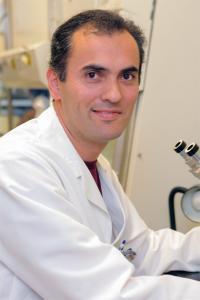Hasan Orhan Akman, PhD
- Associate Professor of Neurological Sciences (in Neurology) at the Columbia University Medical Center

Overview
Academic Appointments
- Associate Professor of Neurological Sciences (in Neurology) at the Columbia University Medical Center
Research
I am working on diagnosis and treatment of metabolic disorders that cause neuromuscular diseases, particularly glycogen storage disorders. Glycogen is the main form of carbohydrate storage in animals (starch in plants with less branched form) and occurs primarily in the liver and muscle tissue. It is readily converted to glucose as needed by the body to satisfy its energy needs. The synthesis of glycogen is catalyzed by the sequential action of two enzymes: (i) glycogen synthetase which attaches glucose molecules together, after approximately 7 to 11 glucose units added (ii) the branching enzyme hydrolyzes approximately 4 glucose unit long chain and attaches to same or adjacent chain. This branching activity is very important to synthesize soluble and functional glycogen molecule. In case of lower activity or absence of the glycogen branching enzyme, an abnormal very long branched polyglucosan accumulates in multiple tissues including liver, central nervous system, skeletal and heart muscles and cause glycogen storage disease (GSD) type IV (OMIM232500). Since the carriers are not affected this is an autosomal recessive disorder. Absence of enzyme activity (Anderson's disease) is embryonic lethal due to liver, heart and muscle failure. 10 to 15% of normal branching activity leads to a late onset clinical variant known as adult polyglucosan body disease (APBD) and progress as a neurodegenerative disorder.
Our goal is to produce an animal model for APBD that can be used in experiments to understand the mechanism of the disease and develop methods and pharmaceutical reagents for the treatment. In order to achieve this goal we introduced a common human mutation, which substitutes 329th amino acid tyrosine with serine, in to mouse GBE1 gene. Affected animals have very severe accumulation of polyglucosan bodies in muscle heart, liver and to a lesser extend in spinal cord. Currently we are breeding those animals in order to characterize the effect of mutation in their neuromuscular functions and behavior. In collaboration with Dr Minassian (Hospital of Sick Children at Toronto, Ontario CA) we will try FDA approved chemicals to stop the accumulation of polyglucosan bodies in those animals. In two years we may have a compound which can prevent polyglucosan formation in tissue. In our laboratory we will also try different approaches that help the cells to breakdown polyglucosan bodies. All together these experiments will yield invaluable information for the behavior of the accumulated material in the cells and ways to eliminate them. Our methods might be applied to other storage diseases like Pompeii (GSD II), Alzheimer, Parkinson and Huntington's diseases.